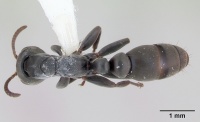Pseudomyrmex fortis
| Pseudomyrmex fortis | |
|---|---|

| |
| Scientific classification | |
| Kingdom: | Animalia |
| Phylum: | Arthropoda |
| Class: | Insecta |
| Order: | Hymenoptera |
| Family: | Formicidae |
| Subfamily: | Pseudomyrmecinae |
| Genus: | Pseudomyrmex |
| Species: | P. fortis |
| Binomial name | |
| Pseudomyrmex fortis (Forel, 1899) | |
Aggressive ants that act quickly to defend their nesting plant.
Identification
Ward (1999) - Key distinguishing features of P. fortis are the relatively large size yet elongate head (worker CI 0.81–0.86, queen CI 0.72–0.73), relatively short eyes in relation to head length (worker REL 0.57–0.59, queen REL 0.53–0.56), broad and subglobose petiole, with prominent anteroventral process, and unicoloured body. The worker has well separated frontal carinae and a broad profemur (FI > 0.47). P. fortis bears little close resemblance to Pseudomyrmex sericeus which is smaller (worker HW < 0.95), with closely contiguous frontal carinae, elongate eyes (worker REL ≈ 0.65), a short high propodeum whose basal and declivitous faces meet at an angle, and a petiole which is subtriangular in lateral profile.
Distribution
Mexico, Central America, Colombia and Venezuela.
Latitudinal Distribution Pattern
Latitudinal Range: 18.917° to 11°.
| North Temperate |
North Subtropical |
Tropical | South Subtropical |
South Temperate |
- Source: AntMaps
Distribution based on Regional Taxon Lists
Neotropical Region: Colombia, Costa Rica, Guatemala, Mexico (type locality), Panama, Venezuela.
Distribution based on AntMaps
Distribution based on AntWeb specimens
Check data from AntWeb
Countries Occupied
| Number of countries occupied by this species based on AntWiki Regional Taxon Lists. In general, fewer countries occupied indicates a narrower range, while more countries indicates a more widespread species. |

|
Estimated Abundance
| Relative abundance based on number of AntMaps records per species (this species within the purple bar). Fewer records (to the left) indicates a less abundant/encountered species while more records (to the right) indicates more abundant/encountered species. |

|
Biology
Ward (1999) - Little is known about its biology, but Wheeler (1913, 1942) reported the species inhabiting Triplaris melaenodendron (as T. auriculata) at Patulul and Escuintla, Guatemala, and he indicated that the workers sting readily. Wheeler & Bailey (1920:264) examined larval food pellets of these P. fortis and found remains of insects, fungi, and bits of “medullary tissue evidently gnawed from the walls of the myrmecodomatia by the workers”. A population of P. fortis in northern Colombia — with somewhat divergent morphology, the workers being small with short petioles — also has aggressive workers, which inhabit live Avicennia branches and tend coccids of the genus Cryptostigma (Ward, 1991). I suspect that P. fortis will prove to be a “generalist” plant-ant species, i.e. one which, like Pseudomyrmex viduus, Pseudomyrmex rubiginosus, and some Azteca species (Longino, 1996), occupies a variety of live plant cavities.
Castes
Nomenclature
The following information is derived from Barry Bolton's Online Catalogue of the Ants of the World.
- fortis. Pseudomyrma sericea var. fortis Forel, 1899c: 89 (w.) MEXICO. Combination in Pseudomyrmex: Kempf, 1972a: 223. Raised to species: Ward. 1999b: 520.
Unless otherwise noted the text for the remainder of this section is reported from the publication that includes the original description.
Description
Worker
Ward (1999) - Measurements (n=10). HL 1.14–1.38, HW 0.96–1.15, MFC 0.038–0.068, LHT 0.72–0.93, CI 0.81–0.86, REL 0.57–0.59, REL2 0.67–0.71, FCI 0.04–0.06, FI 0.48–0.50, PLI 0.90–1.10, PWI 0.81–0.92.
Worker description. A member of the sericeus group. Palp formula: variable (6,4 or 5,4). Frontal carinae well separated; head somewhat elongate, sides weakly convex; posterior margin of head concave, in frontal view. Profemur broad; legs relatively short (LHT/HL 0.62–0.70). Dorsal face of propodeum subequal in length to declivitous face, and rounding gradually into it; propodeal spiracle distant from basal (dorsal) face of propodeum. Petiole subglobose, rounded in profile, with a single convex anterodorsal face, which rounds gently into the steep posterior face. Anteroventral process well developed, a triangular or subrectangular lobe, usually with a blunt posteroventral tooth or angle. Standing pilosity sparse; stout, paired setae usually present on pronotum (1–2 pairs), propodeum at junction of basal and declivitous faces (0–1 pair), petiole (1 pair) and postpetiole (1–2 pairs), occasionally additional short hairs present on mesosoma. Dark brown to brownish black; mandibles and frontoclypeal complex a lighter castaneous brown; scape, protibia and protarsus may also be a lighter brown.
Type Material
Ward (1999) - Syntype worker, Atoyac, Veracruz, Mexico (H. H. Smith) (The Natural History Museum) [Examined].
References
- Forel, A. 1899f. Formicidae. [part]. Biol. Cent.-Am. Hym. 3: 81-104 (page 89, worker described)
- Kempf, W. W. 1972b. Catálogo abreviado das formigas da regia~o Neotropical. Stud. Entomol. 15: 3-344 (page 223, Combination in Pseudomyrmex)
- Ward, P. S. 1999b. Systematics, biogeography and host plant associations of the Pseudomyrmex viduus group (Hymenoptera: Formicidae), Triplaris- and Tachigali-inhabiting ants. Zool. J. Linn. Soc. 126: 451-540 (page 520, Raised to species)
References based on Global Ant Biodiversity Informatics
- Fernández F., E. E. Palacio, W. P. Mackay, and E. S. MacKay. 1996. Introducción al estudio de las hormigas (Hymenoptera: Formicidae) de Colombia. Pp. 349-412 in: Andrade M. G., G. Amat García, and F. Fernández. (eds.) 1996. Insectos de Colombia. Estudios escogidos. Bogotá: Academia Colombiana de Ciencias Exactas, Físicas y Naturales, 541 pp
- Fernández F., and E. E. Palacio. 1995. Hormigas de Colombia IV: nuevos registros de géneros y especies. Caldasia 17: 587-596.
- Kempf, W.W. 1972. Catalago abreviado das formigas da regiao Neotropical (Hym. Formicidae) Studia Entomologica 15(1-4).
- Longino J. T., J. Coddington, and R. K. Colwell. 2002. The ant fauna of a tropical rain forest: estimating species richness three different ways. Ecology 83: 689-702.
- Wheeler W. M., and I. W. Bailey. 1920. The feeding habits of pseudomyrmine and other ants. Transactions of the American Philosophical Society (2)22: 235-279.

